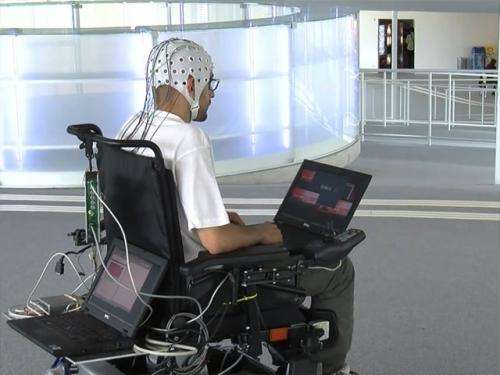April 22, 2014 report
Volitional control from optical signals

(Medical Xpress)—In their quest to build better BMIs, or brain-machine-interfaces, researchers have recently begun to look closer at the sub-threshold activity of neurons. The reason for this trend is that with only a limited number of recording sites availible in any practical interface, researchers want to get the most complete signal possible from each one. The problem with only using spikes from the output pyramidal cells of the cortex, is that relatively speaking, these guys only put out a spike every once in a blue moon. The real story emerges over much shorter timescales within the dendritic networks of these cells. Efforts to use these smaller potentials as indicators of volitional intent, recorded in the guise of calcium signals, has gotten under way by researchers at the University of California at Berkeley.
The team, lead by electrical engineer Jose Carmena, reported their latest results in a recent issue Nature Neuroscience. Using two-photon imaging the group was able to record every cell within a 150 x 150 μm field of view. They focused on layer II-III neurons form the mouse motor or somatosensory cortex which specifically expressed the genetically-encoded calcium indicator gCaMP6f. The mice were trained to modulate their neural activity up or down in response to the changing pitch of an auditory cue. They could learn this task in just a few days and showed continued improvement over a few more.
We recently reviewed a study where researchers similarly trained mice to control synaptic patterns in their hippocampus. These researchers stimulated a feeding area in the lateral hypothalamus, and the animals learned to activate precise patterns to receive even more stimulation. Incredibly the mice learned to do this within 15 minutes. In this case, the potentials were recorded with patch electrodes rather than using optical signals.
Sub-threshold potentials or ion flows can be correlated with the spiking behavior of the cell, but that is not always the case. One could argue that a brainstem oculomotor neuron firing away tonically at over 300 hz just to hold the eye still, or an auditory nerve neuron pulsing away at roughly the same to cue up a particular tone, is doing something vastly different than a pyramidal cell that might rouse itself only once every few seconds to cast its electrical ballot. If we expect that dendritic and synaptic processes still occur at roughly the same rate in such a pyramidal cell, clearly its output is mising a lot of the information that is available to it.
Perhaps then the exceptional spike of the pyramidal cell does a bit more. Is it responding to the one fly among hundreds that gets the horse at pasture to buck, the one tickle too many from the troop that musters the napping papa orangutang to chase off his pestering kin? Or is the spike something the pyramidal beast generates on its own, a dinner bell that summons, or a fair-weathered metronome that synchronizes the far-flung activites of organelles esconced away in its synapses?
In the words of the authors, recording just spikes grossly undersamples cortical processing. Reconstruction algorithms, which attempt to piece together a stimulus, or divine an inner intent, may be difficult to make work unless a rich sampling of different neural phenomena are taken into consideration. These new studies, while needing experimental hardware that is difficult to translate directly to human subjects, now provide essential new clues to how we might extract will from the brain.
More information: Volitional modulation of optically recorded calcium signals during neuroprosthetic learning, Nature Neuroscience (2014) DOI: 10.1038/nn.3712
Abstract
Brain-machine interfaces are not only promising for neurological applications, but also powerful for investigating neuronal ensemble dynamics during learning. We trained mice to operantly control an auditory cursor using spike-related calcium signals recorded with two-photon imaging in motor and somatosensory cortex. Mice rapidly learned to modulate activity in layer 2/3 neurons, evident both across and within sessions. Learning was accompanied by modifications of firing correlations in spatially localized networks at fine scales.
© 2014 Phys.org


















